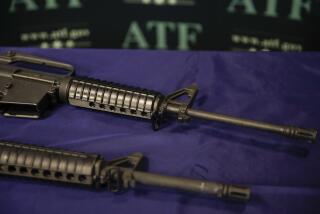Conference Exposes the Real Threat of Fakes
- Share via
Some of the counterfeits were obvious--like the Power Ranger action figures with blurry insignias.
Other looked real. The two bottles of Head & Shoulders shampoo were nearly identical except, of course, for the bacteria in the fake.
That might make you sick. The brake shoes made with wood chips could kill you.
Those were some of the lessons at the biannual meeting Tuesday of the International Anti-Counterfeiting Coalition.
Coalition leaders say that counterfeiting is the “crime of the 21st century,” responsible for $200 billion worth of losses in the United States each year. The counterfeits range from Rolex watches to auto parts, said association President John Bliss.
“No corporation, no product line, no area of the country is immune,” he said.
Counterfeit videos, handbags, office supplies--even birth control pills--are said to cost Californians 25,000 jobs a year. Especially hard hit industries are computer software, entertainment and apparel.
As brand-name goods gain popularity with consumers, Bliss said, “the pirates prey.”
Ripping off the designs of successful products is relatively easy, officials said, with potentially huge profits and little risk of jail time.
To receive even a minimum prison sentence of one year, individuals convicted of counterfeiting merchandise must have been caught selling or trafficking more than $120,000 worth of counterfeit goods. To get the maximum sentence of five years incarceration, the threshold is $8 million worth of fakes.
Conference attendees called on federal officials to adopt tougher penalties.
“We’re not just talking about designer goods,” said Anthony Keats, a lawyer specializing in intellectual property rights. “We’re talking about things that kill people.”
The knockoff brake pads, Bliss said, were blamed in the death of a woman and child.
Counterfeit baby formula, he said, caused rashes and convulsions in infants before it was taken from shelves in more than a dozen states in 1995.
U.S. Customs Service officials said their efforts to catch counterfeiters were helped by the passage two years ago of federal laws allowing higher fines.
Association members said consumers should protect themselves from using fake products by looking for faulty packaging, shoddy stitching, misspelled words and products that lack the manufacturer’s name, bar codes and recycling symbols.
More to Read
Inside the business of entertainment
The Wide Shot brings you news, analysis and insights on everything from streaming wars to production — and what it all means for the future.
You may occasionally receive promotional content from the Los Angeles Times.









